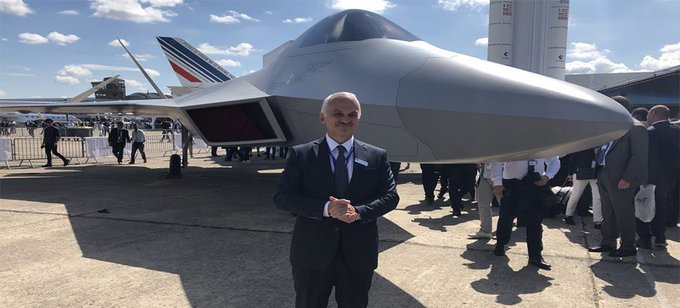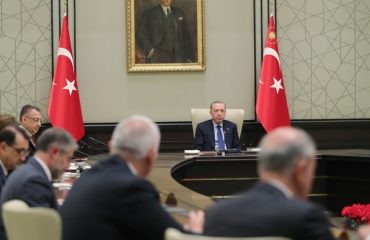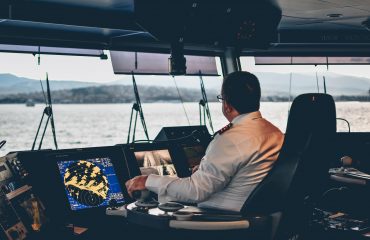

Turkish Aerospace (TA) General Manager Temel Kotil made critical statements about the company and its projects on the CNN Turk channel on November 10, 2021. Kotil gave important information about many projects conducted by TA, “National Combat Aircraft (Milli Muharip Uçak – MMU)”.
MMU is an ambitious project that has come to the public agenda more frequently due to the F-35 crisis between Turkey and United States. Recently, the company announced the production of a structural part of the prototype. Furthermore, Kotil reiterated the importance of investment into advanced technology infrastructure and human resources within the project’s scope. For this reason, MMU can be regarded as one of the steppingstones for Turkey to reach the position of a country that develops and implements advanced technology in the aerospace industry and neighbouring sectors.
The stages that TA has gone through since its establishment are like a summary of not only Turkey’s aviation industry or defence sector but also its foreign policy. Therefore, projects carried out, their characteristics and difficulties encountered are also directly related to the agendas and problems of the sector and Turkey at large.
A brief history of Turkish Aerospace
The roots of the TA can be traced back to Turkey’s 3rd Five-Year Development Plan, which covered the 1973-1977 period. Published in the Official Gazette dated 27.11.1972 and numbered 14374, the plan envisaged an investment of 1.5 billion TL to establish the aircraft industry in Turkey. Most of this budget would come from the “Air Force Foundation”, which pioneered the establishment of the aircraft industry with public support.
Within the scope of the Development Plan, Turkish Aircraft Industry Joint Stock Company (Türk Uçak Sanayii A.Ş. – TUSAŞ) was founded with the Law No. 1784 on 28.06.1973 under the Ministry of Industry and Technology. However, in that period of intense political turmoil, government partners and the military-civilian sides disagreed on which ministry should have control over the company. In addition, the Air Force’s objection to the company’s field of activity and economic problems in the country prevented the formation of the board of directors until 1976, and the company could not start its activities.
Finally, with the resolution of the disputes in 1976, TUSAŞ started to work to establish an aircraft industry in Turkey. One of the first projects was the jet training and light attack aircraft tender. Italy was on the table to sign the contract two times, but the project was not implemented due to the objection of the Air Force. Turkey later acquired T-38 trainer jets from the United States shortly after the arms embargo was lifted in 1978.
The F-16 was selected in 1983 as the next combat aircraft of the Turkish Air Force, and it was decided that procurement was to be realized through joint production. For this mission, TUSAŞ and General Dynamics (later Lockheed Martin) established the TAI (Turkish Aerospace Industries) joint venture company in 1984. For the engines of F-16’s, TUSAŞ and General Electric established TUSAŞ Engine Industries (TEI) in Eskişehir. TAI produced a total of 308 F-16s for the Turkish and Egyptian air forces. The F-16 project formed the backbone of Turkish-US relations, both on military and industrial levels. TAI later undertook CN-235 light transport, SF-260 and AS532 Cougar joint production projects during the 1990s, thanks to the infrastructure and human resources that flourished with the F-16 project.
F35: shifted plans
From the 1990s, TAI embarked on new projects based on risk-sharing and joint development approaches with Europe and the USA, with the experience gained from joint production projects, especially the F-16. A400M, the joint transport aircraft project of Europe, and the being a supplier to Airbus and Boeing as the sole source in the design and manufacture of certain structural parts can be given as examples. Undoubtedly, the warm diplomatic and military relations with these countries contributed to the establishment of much closer cooperation with the US and European companies in the 2000s.
Probably the most crucial indicator of this close cooperation environment was the F-35 project.
Turkey was officially involved in the F-35 Joint Strike Fighter project of the United States from the Concept Demonstration stage with an agreement signed in 1999. This was followed by the System Development and Demonstration phase as Turkey being a Level III partner with the Memorandum of Understanding signed on July 11, 2002. Finally, in 2007, the next phase of the project, Production, Support, and Follow on Development, was initiated.
During these successive stages, the Turkish Air Force shaped their modernization plans based on the F-35. Meanwhile, Turkish aviation industry companies, especially TAI, started to receive various business shares from the project. For example, TAI was chosen as the sole source of the center fuselage, one of the most complex structural parts of the F-35s, outside the USA. For this production, advanced technology infrastructure investments were made in the company’s production facilities. TAI also became one of the two suppliers of certain composite parts of the F-35, the air intake, and external pylons. As of 2016, TAI’s business volume under the F-35 reached $4.5 billion.
However, in response to Turkey’s purchase of the S-400 air defence system from Russia, the USA removed Turkey from the project and cancelled the delivery of the six aircraft produced for the Turkish Air Force.
The road to national combat aircraft
The F-35 was designated as the backbone of the Turkish Air Force from the 2020s. The F-35s, which would replace the F-4E 2020 aircraft, was envisaged to serve alongside an indigenously-developed combat aircraft from the 2030s. In this direction, the “TX/FX” project, as it was then known, was launched in 2011. The initial aim of the project was to develop a fighter aircraft and a trainer aircraft separately. Later on, the project model was revised to cover only the combat aircraft, and the project’s name was changed to “TFX”, also known in Turkish as “National Combat Aircraft” (MMU).
After the conceptual design phase was completed between 2011 and 2013, the preliminary design phase started in 2016. The aim of the project was to develop an aircraft, which has the features of the 5th generation combat aircraft, such as low observability, advanced sensor and communications systems, and high aerodynamic performance. Temel Kotil, while describing the capabilities of this aircraft in his speech on the CNN Türk program, noted that MMU would fall somewhere between the US F-22 and F-35 in terms of capabilities and performance.
The F-22, which entered service with the US Air Force at the end of 2005, is considered the most advanced fighter aircraft globally. The F-35, on the other hand, is an aircraft whose primary mission is strike, and it is equipped with highly advanced sensors and data-link systems. The F-35 is one of the most expensive development projects in history. Along with F-22 and F-35, Russia’s Su-57 and China’s J-20 are regarded as other examples of 5th generation fighters. Serial production of the Su-57, which was also offered to Turkey and was personally introduced to President Recep Tayyip Erdoğan by Russian Federation President Vladimir Putin in 2019, is underway. However, only one Su-57 has entered service with the Russian Air Force so far. The development of the Izdelye 30 engine for the Su-57 is still underway, and the aircraft uses an engine borrowed from Su-35.
Temel Kotil also gave some valuable information about the schedule of the MMU project. Most notably, the “roll-out” date for the aircraft is planned as 2022. Roll-out was previously announced to take place on March 18, 2023. Roll-out means that a prototype’s major and sub-systems, especially its engine, is operational, and the prototype is ready for ground tests. Therefore, roll-out is a significant milestone in an aircraft development project after the maiden flight.
Kotil also said that flight tests will begin in 2025, and serial production will begin in 2028, after three years of testing. Regarding the engines of the aircraft, which is a subject that is a hot topic of discussion in defence circles, Kotil noted that foreign engines will be used in prototypes, and domestic engines will be ready in 2030.
Aims and realities
Turkey’s removal from the F-35 project, rapid modernization of the air forces of countries in the region, and request for F-16s from the USA as a gap-filler solution once again highlighted the importance of the MMU project. Turkey, which claims to be a regional power, previously understood the importance of having operational independence of the armed forces in the 1970s, but the F-35 crisis was a bitter reminder of this lesson.
The military and technological importance of the MMU is obvious. However, the realization of the project depends on the successful management of some risks.
i. Technological factors: Developing the capabilities of a combat aircraft that will enter service in the 2030s and be in service until the 2070s requires a strong foresight capacity for technology, military threat assessment and operational environment. The requirements of the end-user, and military-technological competition in the fields of engines, mission systems, structural parts and weapon systems, are very fluid; and they constantly become challenging. In such a complex environment, research & development, production, and test infrastructures should be improved at such a level that they can develop required technologies and the improvement should be continuous. This is only possible with the existence of a well-constructed technology and industry policy.
ii. Human resources: There has been a brain drain in recent years with an alarming rate, especially in the defence and aerospace industry. Many well-trained and experienced employees prefer to go abroad. The gap created can be easily filled quantitatively, but the main risk here is the absence of experienced personnel who can be described as “medium-level leaders”. The number of employees with technical and administrative experience in projects and who can lead and manage teams of newly graduated or experienced engineers and technicians is rapidly decreasing. In the absence of such staff, costly “trial and error” processes will be run frequently to solve the problems, or it will be necessary to obtain services and consultancy from abroad.
iii. Industry – testing: To undertake development and production in one of the areas where advanced technologies such as combat aircraft are used most intensively necessitates high-cost production facilities, testing, certification infrastructure, but more importantly, the human resources to operate and manage these. There are serious competencies in certain areas for the development and production of a combat aircraft in TAI and its engine in TEI. However, when it comes to mission systems and sub-components, the necessity of establishing an ecosystem emerges. Furthermore, establishing a robust test and certification infrastructure for sub-systems of the aircraft and the aircraft as a whole is critical.
iv. Costs and budget: The development, production and sustainment of a new generation combat aircraft, equipped with advanced technologies and managed by software, are costly processes. Investments are required not only for production but also for the establishment and operation of the development and testing infrastructure, and above all, for sustaining them. Moreover, in order to ensure that the investments made do not remain as one-time, it is essential to ensure their continuity and to preserve highly qualified human resources. When such indirect costs, as well as the production cost of the aircraft, are taken into consideration, it can be claimed that the MMU project will easily have a budget of double-digit billion dollars.
v. International relations: The issues outlined above highlight international cooperation in such complex projects as a necessity to reduce costs and risks by sharing. The existence of a stable relationship between the partner countries is essential for such cooperation, which will take decades and has military, industrial and political dimensions. Due to the technological difficulties and excessive costs of developing combat aircraft, no country, except Russia and China, undertakes such a project alone today: Eurofighter Typhoon (England – Italy – Spain – Germany), Tempest (England – Italy – Sweden), FCAS (France – Germany – Spain) can be given as example. South Korea is developing its own fighter jet in partnership with Indonesia and with the intense technological support of the USA, Israel, and Sweden; Japan is partnering with the UK.
In conclusion, it can be said that the MMU is much more than a military platform development project: It will cause Turkey to face many challenging tests in the fields of technology, industry, and diplomacy.


